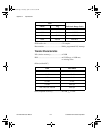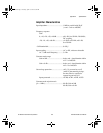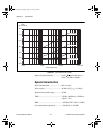
Chapter 6 Theory of Analog Operation
PCI-4451/4452 User Manual 6-12
©
National Instruments Corporation
The DAC
The 64-times oversampling delta-sigma DACs on the PCI-4451 work in the
same way as delta-sigma ADCs, only in reverse. The digital data first
passes through a digital lowpass filter and then goes to the delta-sigma
modulator.
In the ADC the delta-sigma modulator is analog circuitry that converts
high-resolution analog signals to high-rate, 1-bit digital data, whereas in
the DAC the delta-sigma modulator is digital circuitry that converts
high-resolution digital data to high-rate, 1-bit digital data. As in the ADC,
the modulator frequency-shapes the quantization noise so that almost all of
its energy is above the signal frequency (refer to The ADC, earlier in this
chapter).
The digital 1-bit data is then sent directly to a simple 1-bit DAC. This
DAC can have only one of two analog values, and therefore is inherently
perfectly linear. The output of the DAC, however, has a large amount of
quantization noise at higher frequencies, and, as described in the section,
Anti-Image Filtering, some images still remain near multiples of eight
times the sample rate.
Two analog filters eliminate the quantization noise and the images. The
first is a fifth-order, switched-capacitor filter in which the cutoff frequency
scales with the sample frequency and is approximately 0.52 times the
sample frequency. This filter has a four-pole Butterworth response and
an extra pole at about 1.04 times the sample frequency.
The second filter is a continuous-time, second-order Butterworth filter
in which the cutoff frequency (at 80 kHz) does not scale with the sample
frequency. This filter mainly removes high-frequency images from the
64-times oversampled switched-capacitor filter. These filters cause
a delay between the input digital data and the output analog data of
34.6 ±0.5 sample periods.
Calibration
The PCI-4451 analog outputs have calibration adjustments. Onboard
calibration DACs remove the offset and gain errors for each channel.
For complete calibration instructions, refer to Chapter 5, Calibration.
User.book Page 12 Tuesday, April 14, 1998 10:20 AM


















